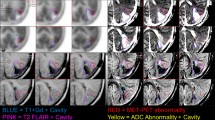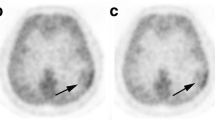Abstract
Object
Following stereotactic radiosurgery (SRS), we examined how to differentiate radiation necrosis from recurrent malignant glioma using positron emission tomography (PET) with11C-methionine (Met).
Methods
Met-PET scans were obtained from 11 adult cases of recurrent malignant glioma or radiation injury, suspected on the basis of magnetic resonance images (MRI). Patients had previously been treated with SRS after primary treatment. PET images were obtained as a static scan of 10 minutes performed 20 minutes after injection of Met. We defined two visual grades (e.g., positive or negative Met accumulation). On Met-PET scans, the portion of the tumor with the highest accumulation was selected as the region of interest (ROI), tumor-versus-normal ratio (TN) was defined as the ratio of average radioisotope counts per pixel in the tumor (T), divided by average counts per pixel in normal gray matter (N). The standardized uptake value (SUV) was calculated over the same tumor ROI. Met-PET scan accuracy was evaluated by correlating findings with subsequent histological analysis (8 cases) or, in cases without surgery or biopsy, by the subsequent clinical course and MR findings (3 cases).
Results
Histological examinations in 8 cases showed viable glioma cells with necrosis in 6 cases, and necrosis without viable tumor cells in 2 cases. Three other cases were considered to have radiation necrosis because they exhibited stable neurological symptoms with no sign of massive enlargement of the lesion on follow-up MR after 5 months. Mean TN was 1.31 in the radiation necrosis group (5 cases) and 1.87 in the tumor recurrence group (6 cases). Mean SUV was 1.81 in the necrosis group and 2.44 in the recurrence group. There were no statistically significant differences between the recurrence and necrosis groups in TN or SUV. Furthermore, we made a 2 x 2 factorial cross table (accumulation or no accumulation, recurrence or necrosis). From this result, the Met-PET sensitivity, specificity, and accuracy in detecting tumor recurrence were determined to be 100%, 60%, and 82% respectively. In a false positive-case, glial fibrillary acidic protein (GFAP) immunostaining showed a positive finding.
Conclusion
There were no significant differences between recurrent malignant glioma and radiation necrosis following SRS in Met-PET. However, this study shows Met-PET has a sensitivity and accuracy for differentiating between recurrent glioma and necrosis, and presents important information for developing treatment strategies against post radiation reactions.
Similar content being viewed by others
References
Chiang CS, McBride WH, Withers HR. Radiation-induced astrocytic and microglial responses in mouse brain.Radiother Oncol 1993; 29: 60–68.
De Witte O, Goldberg I, Wikler D, Rorive S, Damhaut P, Monclus M, et al. Positron emission tomography with injection of methionine as a prognostic factor in glioma.J Neurosurgery 2001; 95: 746–750.
Dethy S, Goldman S, Blecic S, Luxen A, Levivier M, Hildebrand J. Carbon-11-methionine and fluorine-18-FDG PET study in brain hematoma.J Nucl Med 1994; 35: 1162–1166.
Dooms GC, Hecht S, Brant-Zawadzki M, Berthiaume Y, Norman D, Newton TH. Brain radiation lesions: MR imaging.Radiology 1986; 58: 149–155.
Ichinose T, Tsuyuguchi N, Morino M, Sunada I, Ohata K, Takami T, et al. Discrepancy between [18F]fluoro-deoxyglucose and11C-methionine Positron Emission Tomography Findings in Sturge-Weber Syndrome-Case Report-.Neurol Med Chir (Tokyo) 2003; 43: 461–464.
Kracht LW, Friese M, Herholz K, Schroeder R, Bauer B, Jacobs A, et al. Methyl-[(11)C]-L-methionine uptake as measured by positron emission tomography correlates to micro vessel density in patients with glioma.Eur J Nucl Med Mol Imaging 2003; 30: 868–873.
Lilja A, Lundqvist H, Olsson Y, Spannare B, Gullberg P, Langstrom B. Positron emission tomography and computed tomography in differential diagnosis between recurrent or residual glioma and treatment-induced brain lesions.Acta Radiol 1989;30; 121–128.
Ogawa T, Hatazawa J, Inugami A, Murakami M, Fujita H, Shimosegawa E, et al. Carbon-11-methionine PET evaluation of intracerebral hematoma: distinguishing neoplastic from non-neoplastic hematoma.J Nucl Med 1995; 36:: 2175–2179.
Ogawa T, Inugami A, Hatazawa J, Kanno I, Murakami M, Yasui N, et al. Clinical positron emission tomography for brain tumors: comparison of fludeoxyglucose F 18 and l-methyl-11C-methionine.Am J Neuroradiol 1995; 17: 345–353.
Ogawa T, Kanno I, Shishido F, Inugami A, Higano S, Fujita H, et al. Clinical value of PET withl8F-fluorodeoxyglucose and L-methyl-11C-methionine for diagnosis of recurrent brain tumor and radiation injury.Acta Radiol 1991; 32:: 197–202.
Sonoda Y, Kumabe T, Takahashi T, Shirane R, Yoshimoto T. Clinical usefulness of11C-MET PET and201Tl SPECT for differentiation of recurrent glioma from radiation necrosis.Neurol Med Chir (Tokyo) 1998; 38: 342–347.
Szeifert GT, Massager N, Brotchi J, Levivier M. Morphological redifferentiation in a malignant astrocytic tumor after gamma knife radiosurgery.J Neurosurg 2002; 97:: 627–630.
Tsuyuguchi N, Sunada I, Iwai Y, Yamanaka K, Tanaka K, Takami T, et al. Methionine positron emission tomography of recurrent metastatic brain tumor and radiation necrosis after stereotactic radiosurgery: is a differential diagnosis possible?J Neurosurg 2003; 98: 1056–1064.
Yang T, Wu SL, Liang JC, Rao ZR, Ju G. Time-dependent astroglial changes after gamma knife radiosurgery in the rat forebrain.Neurosurgery 2000; 47: 407–415.
Author information
Authors and Affiliations
Corresponding author
Rights and permissions
About this article
Cite this article
Tsuyuguchi, N., Takami, T., Sunada, I. et al. Methionine positron emission tomography for differentiation of recurrent brain tumor and radiation necrosis after stereotactic radiosurgery —In malignant glioma—. Ann Nucl Med 18, 291–296 (2004). https://doi.org/10.1007/BF02984466
Received:
Accepted:
Issue Date:
DOI: https://doi.org/10.1007/BF02984466




